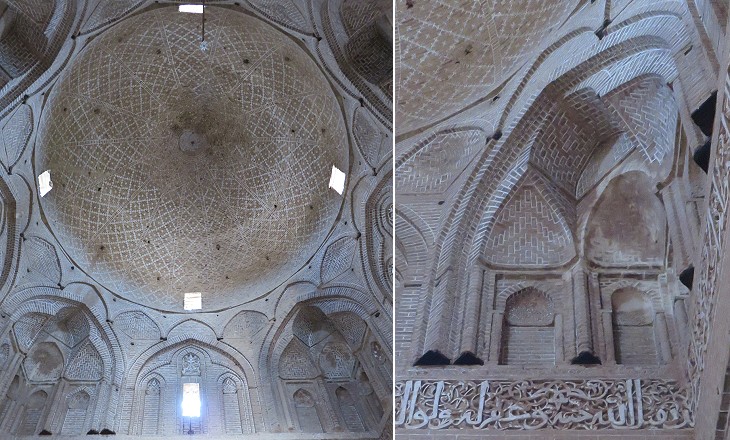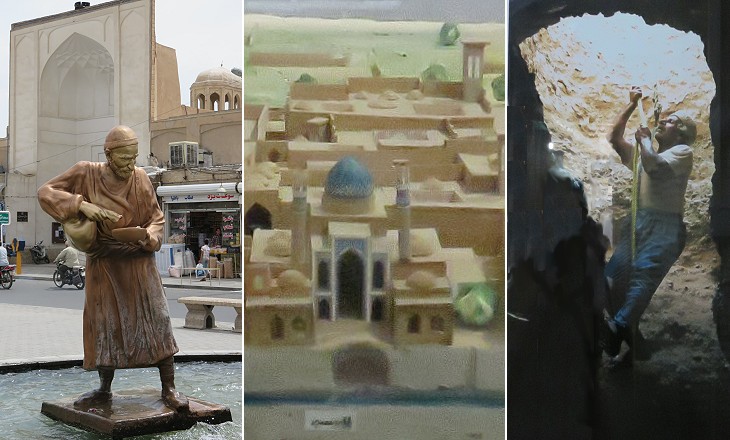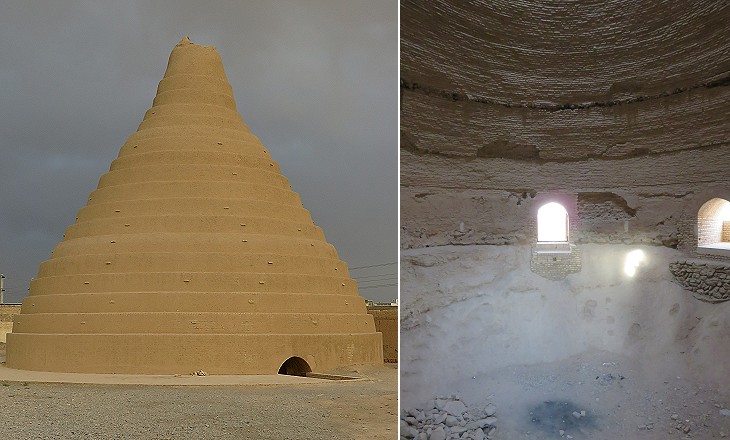  What's New! Detailed Sitemap All images © by Roberto Piperno, owner of the domain. Write to romapip@quipo.it. Text edited by Rosamie Moore. Page added in June 2014. |
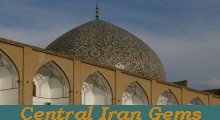 - Ardestan, Zavareh and Abarquh - Ardestan, Zavareh and Abarquh(dome of Sheikh Lotfollah Mosque at Isfahan) You may wish to read an introduction to this section first. During the Xth century the city of Bukhara in today's Uzbekistan became the capital of the Samanid Kingdom which included north-eastern Iran. The Samanids claimed to descend from a Sassanid general and they only formally acknowledged the suzerainty of the Arab Caliphs of Baghdad over their kingdom. They revived the use of Persian (which was now written in the Arabic alphabet) at their court and encouraged the development of Persian culture. They were the patrons of Firdowsi, who, by writing Shahnameh (The Book of Kings), an epic poem on pre-Islamic Persian heroes, laid the basis of modern Persian identity. The Samanids were replaced by the Ghaznavids and the latter were defeated in 1040 by the Seljuks. These were a Turkish-speaking tribe of Central Asia, but they adopted Persian as the official language of their empire. Ghaznavid and Seljuk rulers called themselves sultan, a title meaning having strength/power, which had a lay, rather than religious connotation. In 1071 the Seljuks defeated the Byzantines at Manzikert and occupied part of the Anatolian tableland where they established the Sultanate of Rum. In Persia the Seljuk sultans became known as the Great Seljuks and they set their capital at Isfahan.
Today Ardestan is a small town on the Yazd-Kashan road and is not too far from Isfahan. During the Middle Ages it was one of the most flourishing towns of the region and this is attested by its large Jame Mosque. Jame means both Friday and great/beautiful. The Qur'an requests all male Muslims of a town to attend together the Friday noon prayer so the large mosque where they gather is called Friday/Great Mosque. The Seljuks were followers of Sunni Islam and they promoted the construction of many large mosques and medreses.
Inscriptions indicate that the Friday Mosque was completed by 1158-1160, but it was most likely initiated in ca 1000, prior to the Seljuk conquest. Its exterior has an irregular appearance, whereas the interior is structured around a square courtyard with four iwans, gigantic niches which are a typical feature of Persian architecture since Sassanid times. The iwans were most likely redesigned in the XVIth century, but they were not decorated with tiles, as was customary in that period, a sign that Ardestan had lost importance.
Domes had a special significance in ancient temples and early churches as they symbolized the canopy of heaven, but they were not easy to build. The Romans built the large dome of the Pantheon making use of pozzolana, a very effective mortar. The Byzantine dome of Hagia Sophia was supported by imposing pillars. Seljuk architects found a simpler solution to solve the problem of vaulting a large space. The square area of the Prayer Hall is turned into an octagonal one with four deep niches and eventually sixteen smaller niches support the circular dome. The walls of the Prayer Hall are not wide and the niches partly project from them. The dome structure calls for admiration considering that it has withstood the ravages of time, including earthquakes. The secret of its robustness seems to be the herringbone pattern its bricks are arranged into beneath the stucco decoration.
(I went) to Ardistan, where stucco is used in a new way, to form a kind of filigree over the brickwork. This mosque is Seljuk, dating from 1158, and has the same purity of form, though not in the same degree, as the small dome-chamber in the Friday Mosque at Isfahan. Robert Byron - The Road to Oxiana - Macmillan 1937 (piece written in March 1934).
The decoration of the mihrab with its elaborate stucco carvings is believed to have occurred in the XIIIth century when Ardestan and the whole of Persia were conquered by the Mongols. This decoration recalls that of Ulu Cami (Great Mosque) of Diyarbakir in Eastern Turkey. Kufic script was first developed at Kufa, a town of today's Iraq, and used for writing Qur'ans in the VIIth century. The books reached the countries conquered by the Arabs and the elaborate design of Kufic script favoured its use for decorative inscriptions. These can be seen in most Muslim countries from Tunisia to Central Asia.
Ardestan is located in the proximity of Dasht-e Kavir, a large desert. Its inhabitants had to face extreme heat for most of the year and lack of water. The latter was available at mountain springs and long tunnels (qanats) were excavated to carry it to the town limiting its evaporation. Towers caught the wind and pushed the air downwards reducing its temperature. Shabestans, underground halls built at the qanat level, enjoyed the cooling impact of both the water and the air.
The desert between Isfahan and Yazd seemed broader, blacker, and bleaker than any, despite the warm spring sun. Its only relief was the ventilation-mounds of the kanats, strung out like bowler-hats in rows of ten and twenty miles, and enormously magnified by the clear shimmering air. I remember Noel's* telling me he had calculated that one-third of the adult male population of Persia is perpetually at work on these underground water-channels. They can construct an incline of forty or fifty miles through almost flat country without any instruments, and at never more than a given number of feet below the ground. Robert Byron - The Road to Oxiana - Macmillan 1937 (piece written in March 1934). * Lieutenant-Colonel Edward William Charles Noel, a British diplomat.
Zavareh is situated twelve miles from Ardestan on the very edge of the desert. It was a lively town in the XIIth century, but today it is almost a village. It has retained to some extent its original urban layout and its yellow colour which turns pinkish at sunset. Original urban layout and colour have almost entirely disappeared from great cities such as Isfahan, Kashan, Yazd and Shiraz.
This mosque is dated 1135 and it is the first one to have a four iwan layout. It does not seem to have been significantly modified as it retains the original Kufic inscription made up of bricks, a detail of which is shown in the image used as background for this page.
The ban on depiction of living beings was a major limit to the decoration of Muslim buildings. In its more rigid interpretation it was not limited to human beings and animals, but it included flowers and trees. The decoration of the mihrab shown above is based on a floral/plant motif, but it is difficult to exactly say which flower/plant it depicts. The town of Divrigi in Eastern Turkey has several examples of decorations of the same period based on actual or idealized flowers/plants.
Abarquh is another small town on the edge of a desert, but it is situated along the Shiraz-Yazd road. It is known for a gigantic cypress and for a mausoleum built on a hill near the town. Isolated mausoleums (gonbad in Persian and kumbet in Turkish) are typical of Seljuk architecture. Kayseri, a large city in Turkey, is known for its many decorated kumbets and nearby Nigde for that of Hudavent Hatun. Gonbad-i Ali was built in 1055 by the family ruling the town and most likely it had a pyramidal roof rather than a dome.
In summer temperatures in towns near the Persian deserts can easily reach 45C/113F, but in winter they drop to below 0C/30F. During this time of the year water from the qanats was frozen and the ice was stored in large underground spaces which were covered by thick walls. These were made up of a special mortar having insulating effects. The ice was used in summer to chill beverages and to make faloodeh, a dessert (frozen starch vermicelli with syrup of roses and lemon) which is still very popular at Shiraz, as an alternative to ice cream (it does taste good). Introduction Pasargadae and Persepolis Sassanid Bishapur Achaemenid Tombs and Sassanid Reliefs Zoroastrian survivors Seljuk Isfahan XIVth century Yazd Safavid Isfahan XVIIIth century Shiraz Qajar Kashan Post Scriptum On the Road An excursion to Abyaneh Persian Roses People of Iran  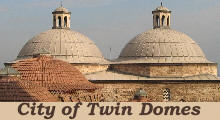 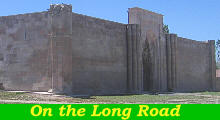 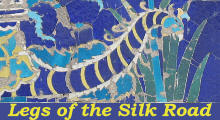 |


